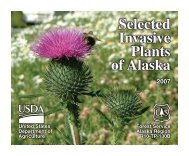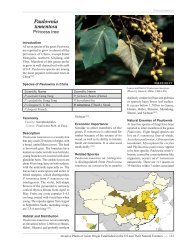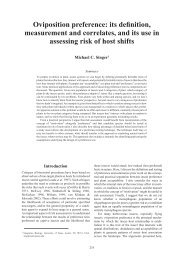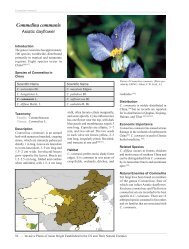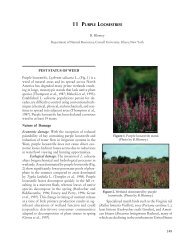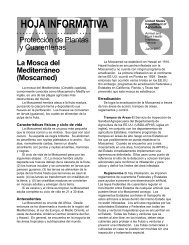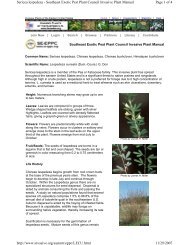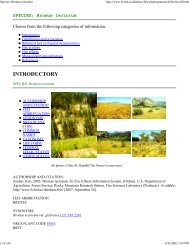A review of literature and field practices focused on ... - Invasive.org
A review of literature and field practices focused on ... - Invasive.org
A review of literature and field practices focused on ... - Invasive.org
Create successful ePaper yourself
Turn your PDF publications into a flip-book with our unique Google optimized e-Paper software.
C<strong>on</strong>clusi<strong>on</strong>s<br />
Patches outside the 100-year floodplain<br />
Cut the patches in [late May through June], <str<strong>on</strong>g>and</str<strong>on</strong>g> then spray in [August through mid-June]<br />
with either glyphosate, triclopyr (Garl<strong>on</strong> 3a) or an herbicide mixture c<strong>on</strong>taining<br />
glyphosate <str<strong>on</strong>g>and</str<strong>on</strong>g> triclopyr at a 2:1 ratio or more <str<strong>on</strong>g>of</str<strong>on</strong>g> glyphosate to triclopyr. For example use<br />
a spray soluti<strong>on</strong> <str<strong>on</strong>g>of</str<strong>on</strong>g> 2% Rodeo, Aquamaster, Gly Star or Round-up <str<strong>on</strong>g>and</str<strong>on</strong>g> 3/4 - 1% Garl<strong>on</strong><br />
3a. Use R-11 or an equivalent surfactant at 1% volume (about 1 oz per gall<strong>on</strong>). Carefully<br />
follow the manufacturer’s instructi<strong>on</strong>s for combining these two (or any) herbicides.<br />
Alternatively, carefully spray the plants as so<strong>on</strong> as they reach 1-2 meters tall as above.<br />
Return late in the summer to check for sprouts. In some circumstances (i.e. isolated<br />
patches <strong>on</strong> cobble bars etc...) you may be able to spray plants that are in bud without an<br />
early seas<strong>on</strong> cutting. Spray tall plants very carefully, desirable plants hit with herbicide<br />
will be injured or killed.<br />
Patches within the 100-year floodplain<br />
Cut the patches in [late May through June], then, when they reach at least 1 -2 meters in<br />
height, <str<strong>on</strong>g>and</str<strong>on</strong>g> if doing spot treatment, spray with a 5-8% soluti<strong>on</strong> <str<strong>on</strong>g>of</str<strong>on</strong>g> herbicide c<strong>on</strong>taining<br />
glyphosate that is labeled for riparian, or better yet aquatic use (i.e. Rodeo, Aquamaster).<br />
For wider, broadcast use, the label specifies a 2% applicati<strong>on</strong> rate. Use a surfactant that is<br />
appropriate <str<strong>on</strong>g>and</str<strong>on</strong>g> legal. As menti<strong>on</strong>ed above NOAA-Fisheries has <strong>on</strong>ly approved LI-700,<br />
but many other surfactants are labeled for use in riparian areas. If a label that includes<br />
stem injecti<strong>on</strong> is approved in your state, c<strong>on</strong>sider using stem injecti<strong>on</strong> <strong>on</strong> all stems large<br />
enough to inject (~0.5-0.75" diameter minimum) <str<strong>on</strong>g>and</str<strong>on</strong>g> spot spraying small stems as above.<br />
Patches overhanging water (revised with informati<strong>on</strong> from Oreg<strong>on</strong> TNC 2005 S<str<strong>on</strong>g>and</str<strong>on</strong>g>y<br />
River report)<br />
It is probably a good idea to minimize herbicide water c<strong>on</strong>tact. Too little is known about<br />
sub-lethal effects <str<strong>on</strong>g>of</str<strong>on</strong>g> many herbicides <strong>on</strong> aquatic fauna to justify disregard. [Stem<br />
injecti<strong>on</strong> seems to be the optimal choice in this situati<strong>on</strong>.] An integrated approach in<br />
which stems are cut, <str<strong>on</strong>g>and</str<strong>on</strong>g> then sprayed when they are short enough to prevent drift into<br />
water is probably the next best [method]. A [still] less attractive opti<strong>on</strong> is to use a wiping<br />
approach <strong>on</strong> the stems closest to the water. [See N<strong>on</strong>-Target Impacts secti<strong>on</strong> for<br />
discussi<strong>on</strong> <str<strong>on</strong>g>of</str<strong>on</strong>g> potential herbicide root/rhizome leakage, especially in coarse soils with<br />
high water tables]<br />
There are few methodical studies investigating the ecological impacts <str<strong>on</strong>g>of</str<strong>on</strong>g> knotweed<br />
infestati<strong>on</strong>s. There are a number <str<strong>on</strong>g>of</str<strong>on</strong>g> assumed negative impacts including, decreased<br />
native plant diversity, decreased habitat value, increased bank erosi<strong>on</strong> <str<strong>on</strong>g>and</str<strong>on</strong>g> disrupted<br />
aquatic food webs. There is a need for measured studies to provide sound informati<strong>on</strong> to<br />
include in cost/benefit analysis <str<strong>on</strong>g>of</str<strong>on</strong>g> knotweed c<strong>on</strong>trol. It would be best if practiti<strong>on</strong>ers<br />
could wait for more informati<strong>on</strong> to include in decisi<strong>on</strong> making, but the potential for<br />
knotweed to rapidly spread within riparian systems mayrequire acti<strong>on</strong> based <strong>on</strong><br />
incomplete informati<strong>on</strong>. Without timely c<strong>on</strong>trol, knotweed has the potential to spread<br />
<str<strong>on</strong>g>and</str<strong>on</strong>g> make any future c<strong>on</strong>trol efforts immensely more resource intensive.<br />
If knotweed is found to be spreading in a riparian system, planning should happen from a<br />
watershed perspective. Mapping knotweed st<str<strong>on</strong>g>and</str<strong>on</strong>g>s <str<strong>on</strong>g>and</str<strong>on</strong>g> then strategically planning c<strong>on</strong>trol<br />
25




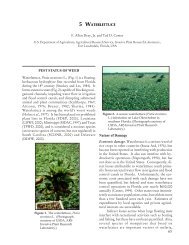

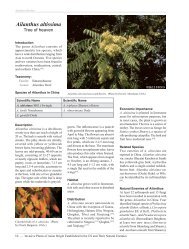
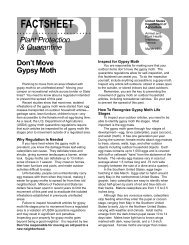
![A Guide to the Control and Management of Invasive Phragmites [PDF]](https://img.yumpu.com/27321025/1/190x190/a-guide-to-the-control-and-management-of-invasive-phragmites-pdf.jpg?quality=85)
